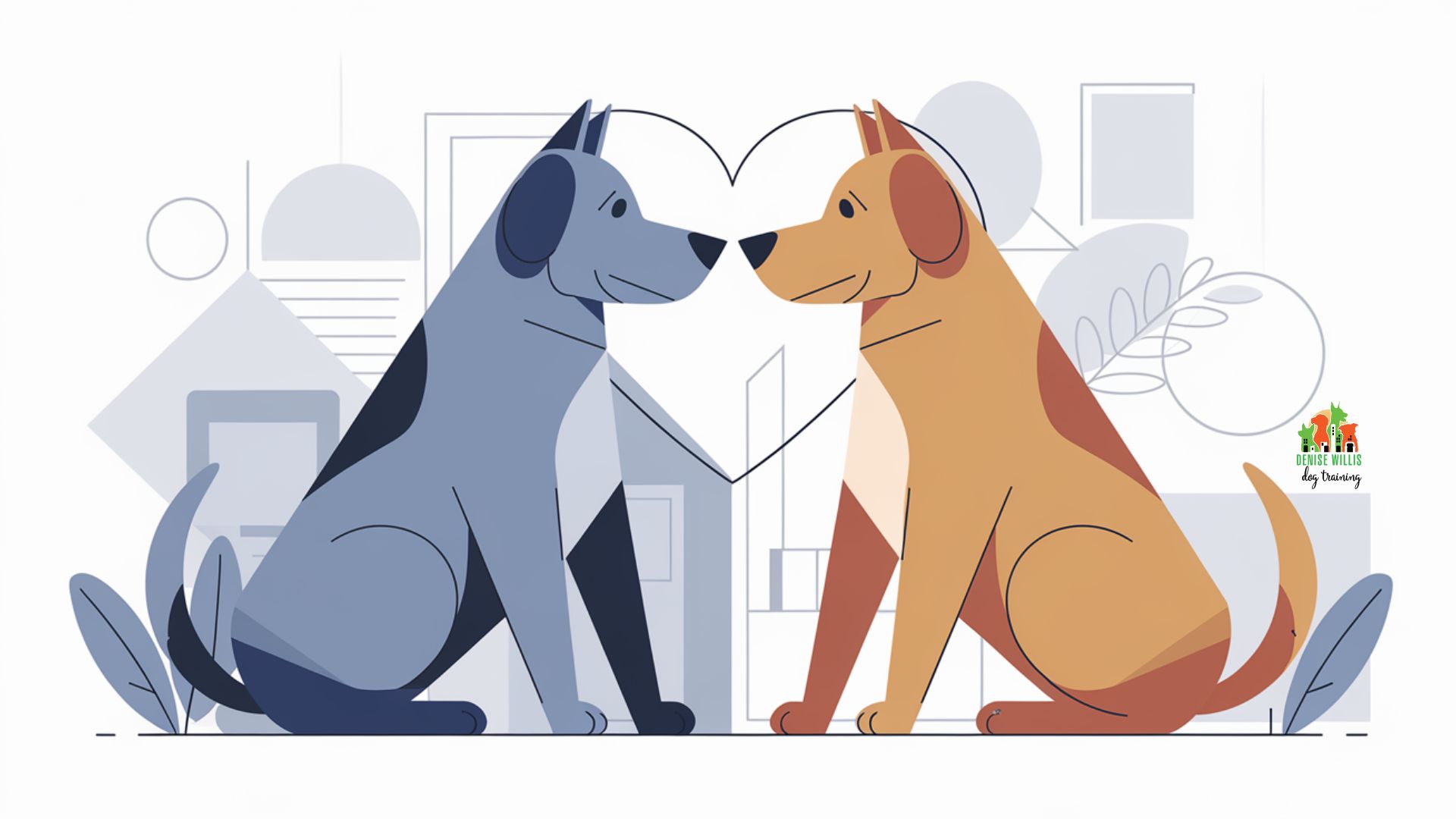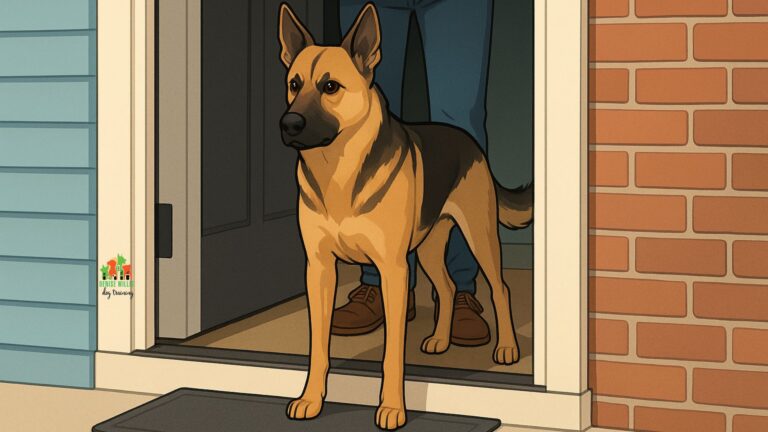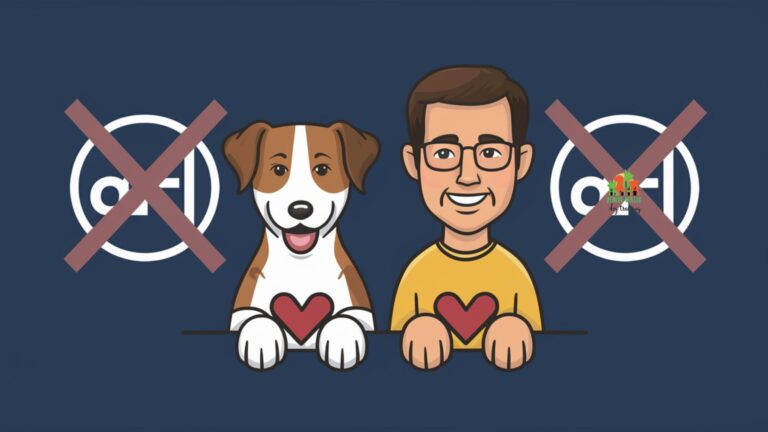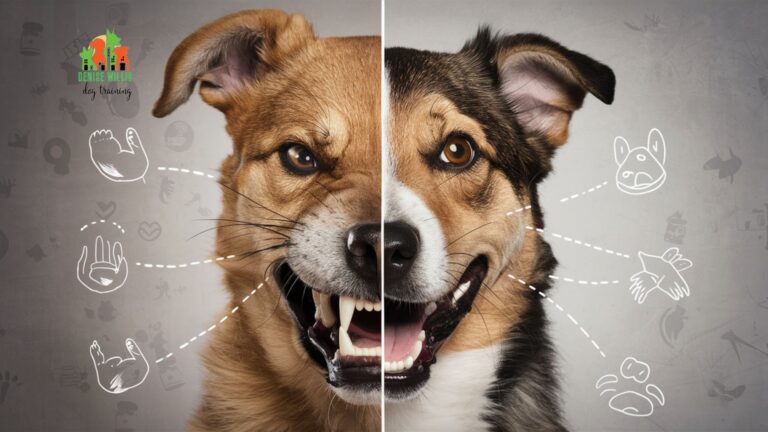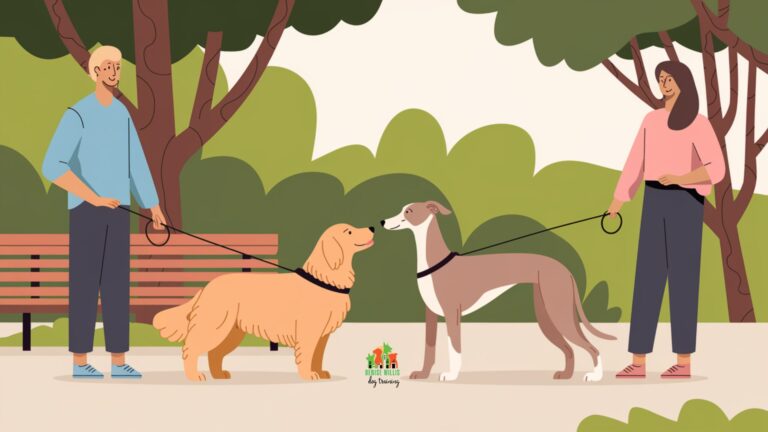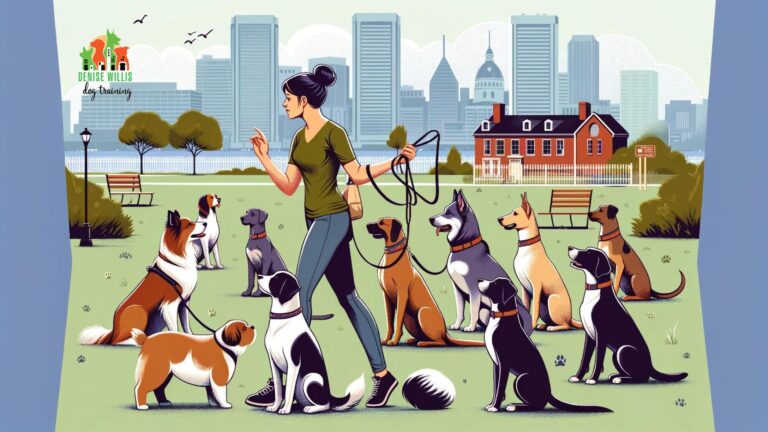Keeping the Peace: Managing Dog Aggression in Multi-Dog Homes
📍 Service Area Notice: DW Dog Training provides in-person training services exclusively in the Greater Baltimore area. While our blog content is designed to help dog owners internationally, our hands-on training services are locally focused. For readers outside our service area, we hope you find value in our articles and welcome you to reach out with questions!
Picture this: One minute you’re enjoying the peaceful sight of your dogs lounging together, and the next – chaos erupts like someone announced free bacon for all. Suddenly your living room transforms into a canine version of Fight Club (first rule: we don’t talk about who started it). If this scene feels familiar, you’re among countless families navigating the dynamics of dog aggression in multi-dog homes.
Key Takeaways
- Success comes through understanding dog dynamics, not playing referee
- Strategic management prevents conflicts better than crisis intervention
- Professional assessment tools provide road maps for lasting solutions
- Consistent family participation creates sustainable harmony
- Most aggressive behaviors improve with proper intervention protocols
Understanding Multiple Dog Dynamics
Living with multiple dogs is like managing a furry version of a reality TV show – complete with alliances, dramatic moments, and occasional conflicts over who gets the best spot on the couch. While most dogs naturally sort out their social dance cards over time, some situations require human intervention to keep the peace. Before you start pricing single-dog households on Zillow, understanding these foundational elements can help create an environment where all your dogs feel secure and respected – without anyone needing their own private suite.
The Numbers Behind the Drama: What Research Tells Us
Think your house has gone to the dogs?
You’re not alone in this furry soap opera!
Before we start handing out Academy Awards for “Most Dramatic Performance in a Living Room,” let’s peek behind the curtain at what science tells us about these canine conflicts. Spoiler alert: The statistics might surprise you more than finding out who really stole that squeaky toy!
| Category | Percentage | Description | Source |
|---|---|---|---|
| Same-Sex Aggression | 79% | Cases involving same-sex pairs | [2] |
| Female Dog Involvement | 68% | Cases involving female dogs | [2] |
| Age Factor | 74% | Aggressors are younger dogs in the pair | [2] |
| New Addition Impact | 70% | Instigators are newer additions to household | [2] |
| Multiple Home History | 41% | Dogs with history of living in multiple households | [2] |
| Late Adoption | 39% | Dogs adopted after 12 weeks of age | [2] |
| Shelter Origin | 33% | Dogs acquired from shelters | [2] |
| Treatment Success | 69% | Overall improvement reported after treatment | [2] |
| General Dog Aggression | 22% | Dogs showing aggression toward unfamiliar dogs | [3] |
| Household Dog Aggression | 8% | Dogs showing aggression toward household dogs | [3] |
Well, there you have it! Those numbers paint quite the picture, don’t they? Like finding out that same-sex pairs are the Real Housewives of the dog world, starring in 79% of the drama!
And those younger pups?
They’re not just acting out their rebellious phase. They’re actually the instigators in 74% of cases. (Someone needs to tell them that being the family troublemaker isn’t actually a career path.)
But here’s the plot twist that would make any reality show producer jump for joy: 69% of cases show improvement after proper treatment! That’s better odds than your chances of guessing who’s going to win Best Performance in the “Looking Guilty Near the Overturned Trash Can” category!
Normal vs. Problematic Behaviors
Think your dogs are auditioning for a WWE career?
Not so fast.
Dogs communicate through a sophisticated language of subtle signals that often look more dramatic than they really are. A raised lip or stiff posture might seem like the prelude to chaos, but it’s actually your dog’s version of saying “Please respect my personal space bubble.” What humans perceive as aggressive displays often represent normal canine communication that requires no intervention.
Social Structure Basics
Forget what you heard about alpha dogs running the show like tiny furry dictators. Modern research reveals that dog social structures have more in common with a flexible corporate hierarchy than a rigid monarchy. Some dogs might be the CEO of toy time while happily letting others manage mealtime operations. This fluid approach to resource sharing actually creates more stable households – when we humans don’t try to force our own organizational chart.
Reading Body Language
Your dogs aren’t subtle about sharing their feelings. You just need to know what to look for. Those side-eyes aren’t your dog practicing for a teenage attitude problem; they’re actually crucial communication signals. Studies show that same-sex pairs account for 79% of reported aggression cases, making it essential to recognize these warning signs early.
Key Factors in Multi-Dog Harmony
Same-Sex Dynamics
79% of aggression cases involve same-sex pairs, with female dogs making up 68% of these incidents. Extra attention needed for same-sex households.
Age and Timing
74% of aggressors are younger dogs, with 70% being newer additions to the household. Introduction timing and age differences matter significantly.
Background Impact
41% of aggressive dogs lived in multiple homes, and 39% were adopted after 12 weeks. Early socialization and stable environments prove crucial.
Treatment Success
69% of cases show improvement with proper intervention. Professional guidance and consistent training lead to positive outcomes.
Professional Assessment and Safety
Before you start googling “how to become a dog psychologist” or consider building separate wings for your feuding furry family members, let’s talk about professional assessment. Like a skilled detective investigating a case, proper evaluation uncovers the real story behind those dramatic showdowns. And trust me – it’s rarely about who really had the squeaky toy first.
SAFER™ Assessment Components
Think of the SAFER™ assessment as your dog’s personality profile – minus the zodiac sign and favorite color. This systematic approach examines everything from how your dog handles being touched to their reaction when someone approaches their food bowl. It’s like a canine job interview, except the only qualification needed is being their authentic self.
Risk Factor Analysis
If you’re wondering whether your dogs’ spats put you in rare company, here’s the scoop: same-sex pairs account for 79% of reported aggression cases, with female dogs involved in 68% of incidents. Think of it as the canine version of sibling rivalry, just with more fur flying. Younger dogs or new additions typically start 74% of these doggy disagreements, proving that age really does come with wisdom – or at least better conflict resolution skills.
Trigger Documentation Methods
Playing detective with your dogs’ disputes isn’t just for fun (though keeping a “bark diary” does have a certain charm). Recording when and where conflicts occur helps identify patterns faster than your pups can raid an unguarded trash can. Think of it as creating a map of your household’s hot spots – minus the actual heat map, unless you’re really committed to the cause.
Progress Tracking Systems
Just like tracking your fitness goals or coffee consumption (no judgment), monitoring your dogs’ behavioral changes provides concrete evidence of improvement. Studies show that 85% of dogs show significant improvement after proper behavior modification programs. That’s better odds than most New Year’s resolutions!
Warning Signs and Critical Indicators
Let’s face it. Your dogs aren’t plotting world domination during those intense staring contests (probably). But they are sending signals clearer than your teenager’s eye rolls. Understanding these warning signs can help you prevent World War Fur from breaking out in your living room.
Red Flag Behaviors
Remember that time your dog gave you the side-eye that rivaled your mother-in-law’s holiday dinner disapproval?
That’s actually them communicating!
Alliance aggression – where dogs only fight in your presence – tops the list of behaviors requiring immediate professional attention. It’s like they’re staging their own reality TV show, just with more dramatic growls and fewer confessional interviews.
The Road to Harmony: Dog Aggression Treatment Timeline
Initial Phase: The First Steps (Weeks 1-2)
Think of this as dog training boot camp! Week 1 kicks off with a full vet check-up and setting up your home like a canine United Nations – complete with peace-keeping barriers (gates and crates). By Week 2, we’re establishing the “Nothing in Life is Free” program, because even dogs need to learn there’s no such thing as a free lunch!
Assessment Phase: Detective Work (Weeks 3-4)
Time to channel your inner Sherlock Holmes! Week 3 focuses on cracking the case of what triggers the drama, while Week 4 is all about evaluating our peace-keeping strategies. Some pups might even start their “chill pills” journey – because sometimes everyone needs a little help staying cool!
Treatment Phase: Peace Negotiations (Months 2-3)
Welcome to doggy diplomacy! We’re talking supervised meet-and-greets, basket muzzles (think of them as formal wear for important meetings), and dragging leashes (the canine version of training wheels). By month 3, we’re seeing that magic 69% improvement rate – better odds than your March Madness bracket!
Maintenance Phase: The New Normal (Months 4-6)
The final stretch! We’re gradually removing the training wheels and seeing if our furry friends can play nice without constant supervision. By month 6, we’ll know if we’ve achieved peaceful coexistence or if we need a more permanent solution. Think of it as graduation day – some dogs get their “Getting Along” diploma, while others might need some extra credit!
Prevention Strategies
Think of preventing dog fights like avoiding family drama at Thanksgiving dinner – strategic seating arrangements and careful planning make all the difference. Early intervention in puppies shows a stunning 92% success rate in preventing resource guarding. Those are better odds than your brackets for March Madness!
Space Management
Your home doesn’t need to look like a doggy prison complex to keep the peace. Creating distinct spaces using baby gates and designated rest areas reduces conflict by up to 65%. Think of it as giving each dog their own studio apartment within your house – complete with all the amenities (aka toys and comfy beds) but minus the ridiculous rent.
Resource Distribution
Playing fair isn’t just for kindergarten. Multiple feeding stations and duplicate high-value toys can reduce resource-based aggression by 70%. It’s like giving each kid their own iPad – suddenly, peace descends upon the kingdom.
Training Solutions
If your dogs’ idea of sharing involves growls that would make a wolf pack proud, don’t worry. Modern training approaches focus on changing minds, not just managing bodies. Think of it as dog therapy, just without the couch (unless that’s what they’re fighting over).
Positive Reinforcement Techniques
Forget about being the “alpha” – unless you’re planning to howl at the moon and eat raw caribou. Modern behavioral science shows that positive reinforcement creates lasting changes in 85% of cases. That’s right – you can literally treat your way to better behavior!
Counter-Conditioning
Think of counter-conditioning like changing your dog’s emotional playlist from heavy metal to smooth jazz. Studies show this approach reduces aggressive responses in 78% of cases within the first month. No actual jazz required (though it couldn’t hurt).
Special Situations
Just like that one relative who needs their own special menu at every family gathering, some situations require extra finesse. Whether you’re dealing with a senior dog who’s become the grumpy old man of the house or trying to teach children that Dog Food Jenga isn’t an Olympic sport, these scenarios need specific approaches.
Working with Children
Kids and dogs can be the best combination since peanut butter and jelly – or the most chaotic duo since mentos and cola. Research shows that 85% of dog bites to children occur in homes where the dog knows the child. Sorry, kids, but Rover isn’t actually guarding his toys because he’s auditioning for “Security Guard: The K9 Edition.”
Senior Dogs
Getting older isn’t just about greying muzzles and afternoon naps. Senior dogs are 60% more likely to develop resource guarding behaviors due to physical discomfort or cognitive changes. Think of it like your grandpa getting cranky about his favorite recliner – except your dog has more teeth.
Professional Support
Sometimes DIY isn’t the answer – unless you enjoy turning simple problems into spectacular disasters (we’ve all been there with home haircuts). Professional intervention leads to successful outcomes in 85% of aggression cases, which beats your success rate with assembling IKEA furniture.
When to Seek Help
If you’re reading this while barricaded in your bathroom because Fluffy and Fido are re-enacting Game of Thrones in the living room, it’s probably time for professional help. Multiple biting incidents or aggression around children top the list of “Get Help Now” scenarios. Consider it like calling a plumber instead of watching YouTube videos while your basement floods.
Working Together Effectively
Success is a team sport – even when the players include humans, dogs, and professionals who speak both languages. Consistent application of training protocols improves outcomes by 73%. That’s higher than your success rate with keeping New Year’s resolutions!
Recovery Journey
Think of rehabilitating dog aggression like teaching your uncle to use a smartphone – progress isn’t always linear, and there might be some entertaining mishaps along the way.
The good news?
Most dogs show significant improvement within 8-12 weeks of consistent training, which is faster than teaching said uncle about cloud storage.
Setting Expectations
If you’re expecting overnight success, you might also believe in unicorns and calorie-free chocolate. Research shows that 92% of successful cases require at least three months of consistent work. Think of it like growing a garden – except instead of tomatoes, you’re cultivating peace and harmony (and fewer vet bills).
Product Recommendations
So your house feels like a canine version of a soap opera, complete with dramatic staredowns and occasional chair-throwing incidents?
We’ve rounded up some peace-keeping equipment that would make the United Nations jealous!
- IRIS USA Exercise 8-Panel Pet Playpen with Door: Finally, a way to give your dogs their own personal space without converting your home into Fort Knox! This portable playpen creates instant boundaries when tensions run high. Perfect for rotating dogs during feeding time or giving someone a cooling-off period. Warning: Dogs might start requesting room service and turndown service.
- PetSafe Busy Buddy Tug-A-Jug Meal Dispensing Dog Toy: Keep those busy minds occupied with something besides plotting couch takeovers. This interactive toy combines play, treats, and mental stimulation – like giving your dog their own puzzle subscription box. Warning: Your dog might start expecting you to make their regular food this entertaining.
- ThunderShirt Sport Anxiety & Calming Vest for Dogs: Like a comforting hug in a jacket! Perfect for dogs who get overstimulated around their housemates. Available in multiple sizes for your whole canine crew. Caution: Your dogs might start trying to squeeze into it together like a furry version of a three-legged race.
- UPSKY 2-in-1 Elevated Dog Bowls Slow Feeder: No more squabbles over the water dishor food selection! This elevated chow and watering spot helps keeps the peace. The no-spill design means less cleanup for you when someone gets too excited about their turn. Warning: Dogs might start expecting separate everything, including their own TV remotes. (Be sure to pick up 2 or more)/
- Snuggle Puppy Behavioral Aid Toy: Give your anxious pup their own comfort companion! With a real heartbeat and heat pack, it’s like a therapy session in plush form. Perfect for dogs who need extra emotional support in multi-dog households. Caution: Your other dogs might get jealous and demand their own support group.
Your furry soap opera cast might not win any daytime Emmy awards, but with these tools, they’ll at least stop trying to recreate dramatic season finales in your living room!
Further Reading
Ready to become the peace-keeping expert your multi-dog household desperately needs? These articles will turn you into a certified diplomat in the world of canine conflicts!
- Same-Sex Aggression in Dogs: Got a pair of pups acting like they’re starring in their own drama series? Learn why same-sex pairs sometimes clash and how to restore harmony without hiring a mediator.
- Dog-to-Dog Resource Guarding: When your dogs treat their toys like they’re protecting the crown jewels, this guide will help you negotiate a peace treaty. No United Nations involvement required!
- How to Manage Your Dog’s Territorial Aggression: Your step-by-step guide to convincing your furry friend that the entire house isn’t actually their personal kingdom. Sorry, pups – democracy wins!
- Decoding Your Dog: 15 Body Language Signals You Need to Know: Become fluent in Dog! Master the subtle art of canine communication without having to bark yourself.
- 10 Warning Signs Your Dog Might Bite and How to Prevent It: Because nobody wants their friendly gathering turning into an impromptu wrestling match. Learn to spot the signs before things get toothy!
Ready to level up your multi-dog management skills?
These reads are like having a Ph.D. in Canine Conflict Resolution – just with more tail wags and fewer student loans!
Frequently Asked Questions About Dog Aggression in Multi-Dog Homes
Q: How can I stop dog aggression towards other dogs in my house?
A: Break out those treats like you’re hosting a doggy game show! Use treats, praise, or toys when your dog allows the other dogs into your room without showing signs of aggression or anxiety. Think of it as rewarding them for being a good roommate – minus the passive-aggressive notes about dirty dishes.
Q: What age does dog aggression typically peak?
A: Just like teenagers discovering hair gel and attitude, dogs hit their drama queen phase between 1-3 years of age. This coincides with sexual maturity, when they become more interested in establishing territory and social status than playing nice with their furry siblings.
Q: Why is my dog suddenly auditioning for WWE with their housemate?
A: Surprise aggression usually stems from resource guarding, dominance, fear, or redirected aggression. Think of it as your dog suddenly deciding they’re the bouncer at Club Living Room – complete with a strict “VIP only” policy.
Q: Can dogs live together after channeling their inner MMA fighters?
A: The short answer? It depends on whether they’re more “minor disagreement” or “full-on vendetta.” If you’re dealing with multiple serious fights or injuries, it’s likely these dogs cannot continue to live together safely. Sometimes, like that roommate who kept eating your labeled leftovers, it’s better to part ways.
Test Your Knowledge: Managing Multi-Dog Mayhem
Final Thoughts
Creating harmony in a multi-dog household isn't rocket science (thank goodness, because most dogs are terrible at math). With patience, consistency, and maybe a sense of humor, your pack can learn to coexist peacefully. Remember, success rates reach 90% with proper management and training - better odds than finding matching socks in the dryer!
Ready for a Peaceful Pack?
At DW Dog Training, we specialize in turning canine chaos into coordinated calm. Whether your dogs are staging WWE matches in the living room or just need some fine-tuning, we're here to help.
Contact us today to start your journey toward a more peaceful pack.
Share Your Story
Got a tale of multi-dog mayhem turned success?
Drop a comment below. Your story might help another family navigate their own furry festivities!

